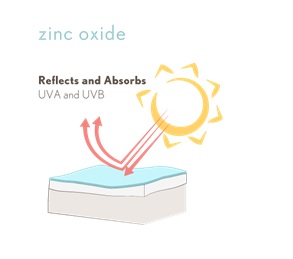Zinc oxide as an ingredient
Zinc oxide has been used topically for centuries. Today, zinc oxide is a key active ingredient in many lotions and mineral sunscreens.
What is zinc oxide and how does it work?
The UV filters (active ingredients) in sunscreens can be divided into two categories: chemical and mineral. Mineral filters, such as zinc oxide, are usually more chemically inert making them ideal for sensitive and baby skin. Mineral sunscreens protect by absorbing, scattering and reflecting harmful UV radiation. Zinc oxide is well known for protecting against a broad spectrum of UV rays.
Zinc oxide is a solid particle and can be naturally sourced. In formulations, zinc oxide sits on top of the skin providing a protective layer. Recent advances in zinc oxide formulation have resulted in sunscreen film applied to the skin without leaving behind a thick, white film. How strongly a zinc oxide sunscreen product protects will depend on how much zinc oxide is used in the formula. Percentages of zinc oxide vary widely and can be up to 25% in sunscreens. In products such as facial moisturizers, zinc oxide is used for coverage.
Mineral Sunscreens for Sensitive Skin in Adults
Adults with sensitive skin are often confused about selecting appropriate skin care products to add into their daily skincare routine. While they want to protect their skin with sunscreen, they don’t want to cause further irritation.
Sensitive skin experts recommend mineral sunscreens that contain zinc oxide and deliver Broad Spectrum UVA/UVB protection with an SPF of 30 or higher. Zinc oxide remains at the surface of the skin and therefore these products do not generally cause reactions, making them ideal for patients with sensitive skin.
zinc_oxide_article.jpg

References
- 20 Common questions about sensitive skin, https://www.webmd.com/beauty/sensitive-skin-20-questions#1
- Misery, L., Sibaud, V., Merial-Kieny, C. and Taieb, C. (2011), Sensitive skin in the American population: prevalence, clinical data, and role of the dermatologist. International Journal of Dermatology, 50: 961–967. doi:10.1111/j.1365-4632.2011.04884.x,
- http://onlinelibrary.wiley.com/doi/10.1111/j.1365-4632.2011.04884.x/abstract;jsessionid=90DCF0A7174A281682DBA113655568ED.f02t04
- National Rosacea Society: Tips for Savvy Sunscreen Use, https://www.rosacea.org/rr/2003/summer/tips.php
- National Rosacea Society: Sunscreen, https://www.rosacea.org/patients/skincare/sunscreen

